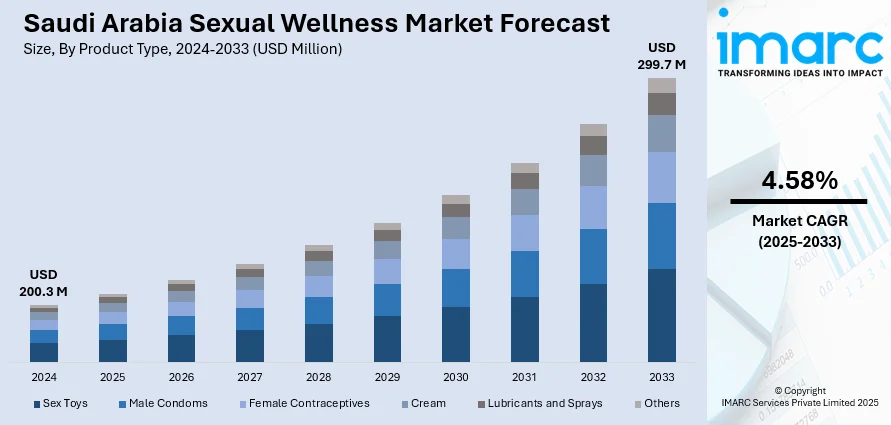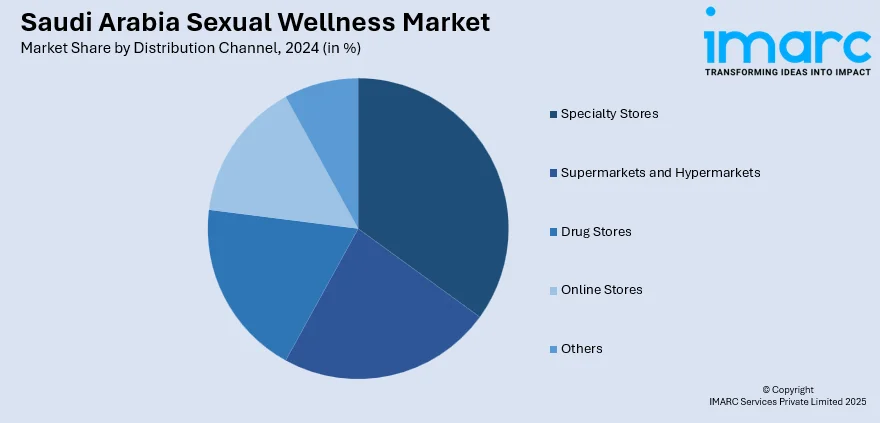
Saudi Arabia Sexual Wellness Market Size, Share, Trends and Forecast by Product Type, Distribution Channel, Application, and Region, 2025-2033
Saudi Arabia Sexual Wellness Market Overview:
The Saudi Arabia sexual wellness market size reached USD 200.3 Million in 2024. Looking forward, IMARC Group expects the market to reach USD 299.7 Million by 2033, exhibiting a growth rate (CAGR) of 4.58% during 2025-2033. Cultural normalization, discreet product access, influence of Vision 2030, private-label expansion, policy relaxation, health-oriented framing, localized packaging, and strategic online retail participation are some of the factors that are positively impacting the market.
|
Report Attribute
|
Key Statistics
|
|---|---|
|
Base Year
|
2024
|
|
Forecast Years
|
2025-2033
|
|
Historical Years
|
2019-2024
|
| Market Size in 2024 | USD 200.3 Million |
| Market Forecast in 2033 | USD 299.7 Million |
| Market Growth Rate 2025-2033 | 4.58% |
Saudi Arabia Sexual Wellness Market Trends:
Cultural Transformation and Gradual Destigmatization of Intimacy Products
Saudi Arabia is undergoing a slow but meaningful cultural shift, particularly among younger population, by being exposed to global norms and wellness narratives. As part of the country’s broader modernization under Vision 2030, there has been increased tolerance for private discourse around topics once considered taboo, including sexual wellbeing. This shift is encouraging a segment of consumers, particularly urban millennials, to discreetly seek products that support personal confidence, relationship satisfaction, and hygiene. Platforms with educational content, often anonymous or influencer-led, are normalizing the use of intimacy products such as lubricants, massage oils, intimate washes, and personal massagers. In parallel, retail outlets have adjusted presentation strategies, offering such products in unbranded aisles or e-commerce-only listings. These efforts provide a socially acceptable way for consumers to access wellness products without direct confrontation. Private-label growth is also evident, as domestic manufacturers identify cultural nuances in formulation and marketing. Through these developments, the Saudi Arabia sexual wellness market share has expanded, with visibility and consumption rising especially in Riyadh and Dammam. A study in Dammam, Saudi Arabia, found that 68.12% of methamphetamine-dependent men experienced erectile dysfunction, with 36.17% reporting mild dysfunction and 10.64% severe dysfunction. This highlights the demand for sexual health solutions in Saudi Arabia, signaling growth potential in the sexual wellness market, particularly in addressing sexual dysfunction linked to substance abuse. While overall penetration is modest relative to global benchmarks, gradual normalization and market segmentation suggest that the category is poised for broader engagement across higher-income, urban consumers.

Policy Liberalization, Private Retail Growth, and Health Framing
The Kingdom’s evolving retail policies have allowed new private-sector players to participate in the sale and distribution of personal wellness products, enabling broader access to sexual health categories. With increased licensing for online stores and specialty retailers, the availability of lubricants, contraceptives, intimate washes, and related products has widened—especially through discreet, door-delivered platforms. These developments align with the state's goal of enhancing quality of life without confronting cultural sensitivities and as a result, Saudi Arabia sexual wellness market growth has been steady within acceptable retail and cultural frameworks. Simultaneously, brands are positioning intimacy products through a wellness and hygiene lens, framing them within acceptable boundaries of health, comfort, and family planning. This approach has improved consumer confidence and supported shelf-presence in drugstores and high-end retail outlets. International brands are also engaging with local distributors to tailor packaging and product messaging to suit social preferences. With more companies adapting their outreach and developing clinically endorsed formulations, the Saudi Arabia sexual wellness market outlook reflects cautious optimism. Ongoing changes in consumer mindset, increased regulatory flexibility, and the discreet growth of health-aligned product lines are creating viable conditions for further market expansion.
Saudi Arabia Sexual Wellness Market Segmentation:
IMARC Group provides an analysis of the key trends in each segment of the market, along with forecasts at the country level for 2025-2033. Our report has categorized the market based on product type, distribution channel, and application.
Product Type Insights:
- Sex Toys
- Male Condoms
- Natural Latex Condoms
- Female Contraceptives
- Cream
- Waist/Hip Lightening Cream
- Hair Removal Foam/cream
- Lubricants and Sprays
- Gels
- Lubes
- Massage Oil
- Others
- Intimate Wash, Foam, Wipes
- Intimate Fragrances, Sprays, Pockets
The report has provided a detailed breakup and analysis of the market based on the product type. This includes sex toys, male condoms (natural latex condoms), female contraceptives, cream (waist/hip lightening cream, and hair removal foam/cream), lubricants and sprays (gels, lubes, and massage oil), and others (intimate wash, foam, wipes and intimate fragrances, sprays, pockets).
Distribution Channel Insights:

- Specialty Stores
- Supermarkets and Hypermarkets
- Drug Stores
- Online Stores
- Others
The report has provided a detailed breakup and analysis of the market based on the distribution channel. This includes specialty stores, supermarkets and hypermarkets, drug stores, online stores, and others.
Application Insights:
- Men
- Women
- LGBT Community
The report has provided a detailed breakup and analysis of the market based on the application. This includes men, women, and LGBT community.
Regional Insights:
- Northern and Central Region
- Western Region
- Eastern Region
- Southern Region
The report has also provided a comprehensive analysis of all the major regional markets, which include Northern and Central Region, Western Region, Eastern Region, and Southern Region.
Competitive Landscape:
The market research report has also provided a comprehensive analysis of the competitive landscape. Competitive analysis such as market structure, key player positioning, top winning strategies, competitive dashboard, and company evaluation quadrant has been covered in the report. Also, detailed profiles of all major companies have been provided.
Saudi Arabia Sexual Wellness Market News:
- On July 23, 2024, Evofem Biosciences signed a license agreement with Pharma 1, to distribute its contraceptive product, Phexxi®, in the Middle East. This partnership is aimed at addressing the growing demand for non-hormonal contraceptive methods in the region, reflecting a shift toward more diverse sexual health products in markets with conservative stances.
Saudi Arabia Sexual Wellness Market Report Coverage:
| Report Features | Details |
|---|---|
| Base Year of the Analysis | 2024 |
| Historical Period | 2019-2024 |
| Forecast Period | 2025-2033 |
| Units | Million USD |
| Scope of the Report |
Exploration of Historical Trends and Market Outlook, Industry Catalysts and Challenges, Segment-Wise Historical and Future Market Assessment:
|
| Product Types Covered |
|
| Distribution Channels Covered | Specialty Stores, Supermarkets and Hypermarkets, Drug Stores, Online Stores, Others |
| Applications Covered | Men, Women, LGBT Community |
| Regions Covered | Northern and Central Region, Western Region, Eastern Region, Southern Region |
| Customization Scope | 10% Free Customization |
| Post-Sale Analyst Support | 10-12 Weeks |
| Delivery Format | PDF and Excel through Email (We can also provide the editable version of the report in PPT/Word format on special request) |
Key Questions Answered in This Report:
- How has the Saudi Arabia sexual wellness market performed so far and how will it perform in the coming years?
- What is the breakup of the Saudi Arabia sexual wellness market on the basis of product type?
- What is the breakup of the Saudi Arabia sexual wellness market on the basis of distribution channel?
- What is the breakup of the Saudi Arabia sexual wellness market on the basis of application?
- What is the breakup of the Saudi Arabia sexual wellness market on the basis of region?
- What is the breakup of the Australia sexual wellness market on the basis of region?
- What are the various stages in the value chain of the Saudi Arabia sexual wellness market?
- What are the key driving factors and challenges in the Saudi Arabia sexual wellness market?
- What is the structure of the Saudi Arabia sexual wellness market and who are the key players?
- What is the degree of competition in the Saudi Arabia sexual wellness market?
Key Benefits for Stakeholders:
- IMARC’s industry report offers a comprehensive quantitative analysis of various market segments, historical and current market trends, market forecasts, and dynamics of the Saudi Arabia sexual wellness market from 2019-2033.
- The research report provides the latest information on the market drivers, challenges, and opportunities in the Saudi Arabia sexual wellness market.
- Porter's five forces analysis assist stakeholders in assessing the impact of new entrants, competitive rivalry, supplier power, buyer power, and the threat of substitution. It helps stakeholders to analyze the level of competition within the Saudi Arabia sexual wellness industry and its attractiveness.
- Competitive landscape allows stakeholders to understand their competitive environment and provides an insight into the current positions of key players in the market.
Need more help?
- Speak to our experienced analysts for insights on the current market scenarios.
- Include additional segments and countries to customize the report as per your requirement.
- Gain an unparalleled competitive advantage in your domain by understanding how to utilize the report and positively impacting your operations and revenue.
- For further assistance, please connect with our analysts.
 Request Customization
Request Customization
 Speak to an Analyst
Speak to an Analyst
 Request Brochure
Request Brochure
 Inquire Before Buying
Inquire Before Buying




.webp)




.webp)












